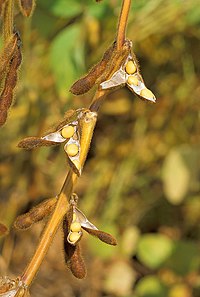
Photo from wikipedia
Water deficiency significantly affects photosynthetic characteristics. However, there is little information about variations in antioxidant enzyme activities and photosynthetic characteristics of soybean under imbalanced water deficit conditions (WDC). We therefore… Click to show full abstract
Water deficiency significantly affects photosynthetic characteristics. However, there is little information about variations in antioxidant enzyme activities and photosynthetic characteristics of soybean under imbalanced water deficit conditions (WDC). We therefore investigated the changes in photosynthetic and chlorophyll fluorescence characteristics, total soluble protein, Rubisco activity (RA), and enzymatic activities of two soybean varieties subjected to four different types of imbalanced WDC under a split-root system. The results indicated that the response of both cultivars was significant for all the measured parameters and the degree of response differed between cultivars under imbalanced WDC. The maximum values of enzymatic activities (SOD, CAT, GR, APX, and POD), chlorophyll fluorescence (Fv/Fm, qP, ɸPSII, and ETR), proline, RA, and total soluble protein were obtained with a drought-tolerant cultivar (ND-12). Among imbalanced WDC, the enhanced net photosynthesis, transpiration, and stomatal conductance rates in T2 allowed the production of higher total soluble protein after 5 days of stress, which compensated for the negative effects of imbalanced WDC. Treatment T4 exhibited greater potential for proline accumulation than treatment T1 at 0, 1, 3, and 5 days after treatment, thus showing the severity of the water stress conditions. In addition, the chlorophyll fluorescence values of FvFm, ɸPSII, qP, and ETR decreased as the imbalanced WDC increased, with lower values noted under treatment T4. Soybean plants grown in imbalanced WDC (T2, T3, and T4) exhibited signs of oxidative stress such as decreased chlorophyll content. Nevertheless, soybean plants developed their antioxidative defense-mechanisms, including the accelerated activities of these enzymes. Comparatively, the leaves of soybean plants in T2 displayed lower antioxidative enzymes activities than the leaves of T4 plants showing that soybean plants experienced less WDC in T2 compared to in T4. We therefore suggest that appropriate soybean cultivars and T2 treatments could mitigate abiotic stresses under imbalanced WDC, especially in intercropping.
Journal Title: Frontiers in Physiology
Year Published: 2019
Link to full text (if available)
Share on Social Media: Sign Up to like & get
recommendations!